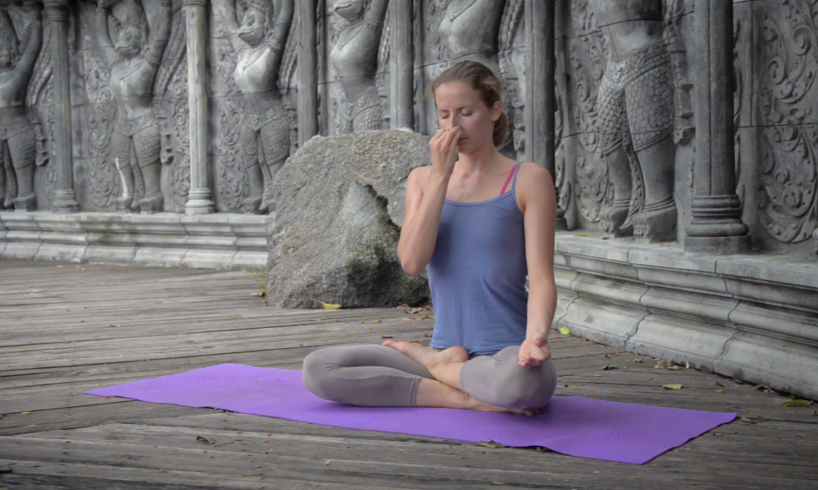
If you are practicing yoga, then you must be practicing pranayama. Yes, Yoga and Pranayama is interconnected to each other. Now, the questions are – how to practice anulom vilom pranayama? Why it is called alternate nostril breathing exercise? What are the benefits of Anulom Vilom Pranayama? Here, I will tell you about this excellent pranayama – Alternate Nostril Breathing or Anulom Vilom.
Many times I am asked why practice Pranayama with Yoga? The answer is simple. When you practice yoga or doing a posture, you are not only doing the posture but also inhale and exhale. You inhale and exhale in a way that your entire body, blood circulation and cardio can reap the benefits from Yoga Poses.
What Is Pranayama?
Prana means Energy + Yama = Control. Therefore Pranayama means control your breath. Many gurus say it is also a meditation technique that helps you learn the various ways of controlling your breathing. In short, it means controlling your breath, where breath is essential energy in our body.
On the subtle level Prana means the “pranic energy” that is responsible for life force on earth and Ayam means “control”. So Pranayama means “Control Of Breath.”
What Are The Types of Pranayama?
When I train people, some of them ask me the types of pranayama. This is a fundamental question, because when you learn something you certainly thing the types, features and benefits involved in it. Now I will tell you the types of pranayama that are generally seen. Generally, five types of Prana are responsible for different types of Pranic activities in our body. They are: Prana, Apana, Vyan, Udana and Samana. Among these five, only Prana and Apana are most essential.
- Natural Breathing
- Basic Abdominal Breathing
- Thoracic Breathing
- Clavicular Breathing
- Yogic Breathing
- Deep Breathing With Ratios
- Fast Breathing
- Voilom or Interrupted Breathing
- Anulom Vilom or Alternate Nostril Breathing
- Cooling Breathing or Sheetali Sitkari And Kaki Mudra
- Ujjayi – Victorious Breath
- Bhramari – Humming Bee Breath
- Bhastrika – Bellow’s Breath
- Surya Bhedan – Right Nostril Breathing
What Is Anulom Vilom Pranayama (Alternative Nostril Breathing)?
Now, let us discuss about Anulom Vilom Pranayama also known as Alternate Nostril Breathing. Sometimes this pranayama is also called Nadi Sodhana pranayama. It is a noteworthy yogic technique that involves controlling of Pranic Energy that I have discussed above.
It is one of the several breathing exercise that is used in the practice of Hatha Yoga. If you are practicing yoga and pranayama then your training must tell you to practice this pranayama every day and the very first day you got to know about this exercise. Yes, it is called a preparatory pranayama.
In this, the first word is ANU and the second world is LOMA, joint has ANULOM. Meaning with grain or natural, and the meaning of VILOM is against the grain. Therefore, Anulom is opposite to Vilom. It means you will breath in one nostril and lose one, and do again from the opposite nostril.
What Are The Benefits Of Anulom Vilom Pranayama?
Anulom Vilom Pranayama is helpful for respiratory related diseases, such as Asthma. It is the best way of balancing your Tri-Dosha. Our body gets ill when the Tri-Dosha are not in proper balance. These Tri Doshas are Vaat or Vatta, Pitta and Kaffa. Here, Tri means Three and Dosha means impurities. Anulom vilom is the simple and best way to purify the Tri Doshas.
The main benefits of Anulom Vilom pranayama is – clearing the blocked of energy channels.
- It helps curing mental issues, such as depression, anxiety, stress, tension and so on.
- It is most beneficial pranayama for breathing related issues, like Asthma or Bronchitis.
- Anulom vilom improves the working of lungs.
- It is the best breathing technique to boost your memory and concentration.
- It makes your brain sharper.
- It improves your immune system; therefore, it cures cough and cold.
- Beyond question, Anulom Vilom is suitable for all people irrespective of the age.
- It is an ideal breathing exercise for maintaining health heart.
Note: Anulom Vilom and Nadi Sodhon is same, just the different name. Anulom vilom is the pranayama and Nadi Sodhon is the next level. First you should practice Anulom vilom and after a few month of practice you can do Nadi Sodhon. Both are same, but in Nadi Sodhona you hold your breath, that’s it.
Steps To Practice Anulom Vilom / Alternate Nostril Breathing
First, close your eyes, and be cool and calm from inside out. Do not take any stress or pressure on your body and mind. Try to be free from all doubts and concentrate on the pranayama.
Second, use your middle finger and thumb to practice this pranayama.
Third, close your eyes sit in Padma Asana or Lotus Pose.
Forth, close the right nostril with your right thumb and take a long breath slowly with your left nostril (Inhale the oxygen as much as you can). When you complete the inhaling, hold for a few seconds, 10 seconds is best.
Fifth, Now, remove your right thumb from your right nostril and hold your left nostril with your middle finger, press properly and exhale the oxygen you took from your right nostril.
This way, you will have to inhale from your right nostril while holding your left nostril with your middle finger, hold the breath for a few seconds and press your thumb on your right nostril and exhale from your left nostril. As simple as that!
Happy Practicing!






Likeed it anulom vilom benefits!! Great article post.Really thank you! Really Cool.
Thank you